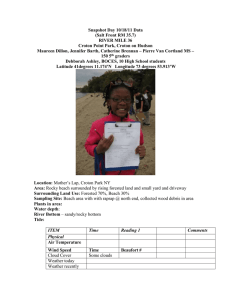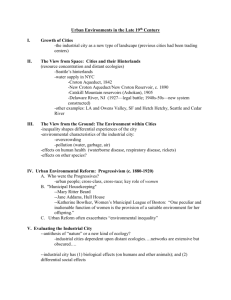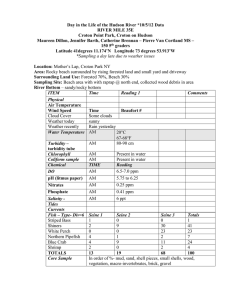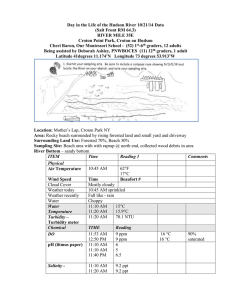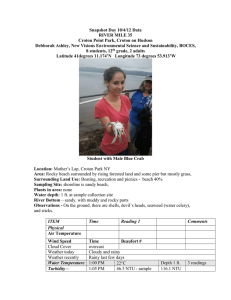Water for the Cities: New York City and The Croton Aqueduct
advertisement
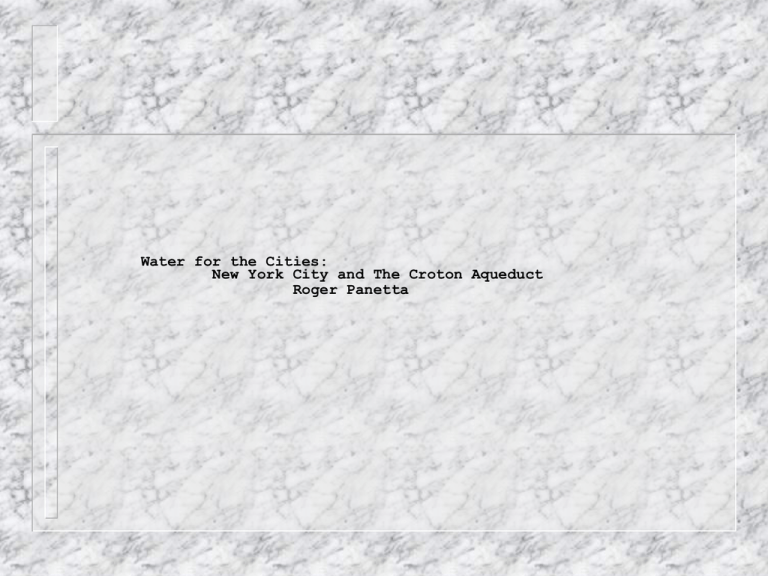
Water for the Cities: New York City and The Croton Aqueduct Roger Panetta Introduction Water Supply an International problem Case study New York City New York Great City World City Great Appetites & Ambitions Historical Struggles on the Path to Greatness Water supply-the Central Roadblock Resolution of the city's first water supply crises Enabled New York to grow Shaped its relationship to the surrounding communities natural resources and the environment conditioned patterns of later responses Result Largest surface water supply in the U.S. High quality water World's best tasting Public Perceptions A permanent reality Invisibility Habits of consumption Source of our water Availability on demand Ignorance of value and history How is this history instructive for the present. Interpretive Frames 1. Tension between Culture & nature Fundamental battle Wilderness subdued Abundance Resources god's special gifts Cultural Anxiety Concerns of writers like Thoreau Hudson River School of painters– Romantics and nature 2. The geographical and resources base Limits to growth and physical expansion Concept of bio-regionalism Nature’s boundaries The Croton Aqueduct and the question of limits Was it precedent setting? 3. Technology, the landscape and politics Building of the CRAQ and the technical knowledge of its day Transforming the City and the Westchester landscape Distribution Power:city-suburb Changing in daily life 4. Chapter in the History of urban development New York City case study Different scale Application to other cities Planners and city fathers Impulse to grow Class and entrepreneurial interests. Public health history and dynamic capitalism h History of 19Century Cities Movement and circulation. People, capital, and water Congestion and Growth 5. Public Health Crises The unhealthy city Polluted water supply Framing the issue Constructing the public health issues Remaking the City's Reputation History and development of the NY water supply Growth of the City Population Unplanned growth "Gotham" Post-war Port(War of 1812) Merchant ascendancy South Street-economic hub of city Packets/Black Ball 1818 1825 Erie Canal opened Commercial supremacy Banking insurance Bureaucracy of business Mapping the Changes Nature v Culture Streets v swamps The Grid 1807 Physical expansion Regularize real estate Topography as obstacle New York as Entrepot Commercial/industrial growth Immigrants cheap labor Rates of immigration Unprecedented density Social and physical danger Backlash The Overwhelmed City Growth outstripped institutional and resource base Shoddy building "The up and down city" Fires Great fires of 1776-1834-1835 Destruction Insurance Companies and Panic 1837 Water resources Disease Fire's twin demon Yellow fever 1798 Cholera epidemic of 1832 1800-1875 Period of the Great Epidemics Context: Warning preparations Street world- business garbagedogs and pigs Offal, breweries, soap-makers Street cleaning/garbage privatized Manure and privies Burial grounds River as sewer Whose responsibility? Cholera Epidemic comes in June 1832 Mortality rates/ sudden and unexpected Flight of the upper class Quarantining the poor and the Use of filth theory/anti-contagionist Weak 19c municipal government/ NYC Crises What’s at Stake? Model in Philadelphia water works The model city. Benjamin Latrobe’s 1801 Schuylkill water supply Fairmont works 1822 Architecture Why was NYC so late? History of NYC Water supply Early drinking water sources The Collect fresh water pond (Foley Square) Polluted 1790s "shocking hole" Animals(Horses)& household garbage City caught up with Collect by 1800 Privies & Pollution NYC water’s distinctive taste Canal to drain the collect The population out stripped the water base Other non-potable sources City needed adequate clean water supply City and public water works. Aaron Burr and the Manhattan Company Private capital and monopoly Chambers St. reservoir 130,000 galls 1796 and profits Triggers for Action-Cholera and Fire 1832 Cholera Impact Shock and Fright NYC Common Council pleas to Albany – Water commissioners Survey of 1835 Croton watershed and river Municipal ownership/state sponsorship Cost Planning the Aqueduct The survey Major Douglas and John Jervis 1835 The Engineer-RR, Bridges, Canals Movement Construction Plan Dam the Croton Create Reservoir, Tunnel across the Harlem Introduce hydraulic engineering Plan a Gravity system Rural vs. urban-power struggle Collapse of the first dam Uproot Community / Repeated pattern second dam 1899 Ashokan Reservoir Westchester Responds Protest property & power Silting of the Croton River Destruction of the Sharon Canal Scheme Transformation of Westchester The Tunnel Plan 40 Mile tunnel 7.5' to 8.5' range in diameter Brick and local stone Shape of tunnel Building the CRA Property owners Irish workers Temperance Public works projects Ventilators and waste weirs Stone culverts and the line Sing-Sing kill and the bridge Harlem River Bridge Traffic vs. siphon The Harlem to Murray Hill Embankments and walls in Manhattan Opening Celebration Oct 1842 Water arrived July 4,1842 Character of celebration Water available Fountains Cost of connection Impact Public baths Closet baths,water closets/indoor plumbing Street clean-ups Consumption increase 1856 expand the reservoir extend the watershed. “Adams Ale” and the dram shops Temperance postponed Sewers and sanitary engineers Edwin Chadwick in England Dr. John Griscom in NYC Private waste and house drains "Water carriage" sewerage 1849-1865 NYC built 125 miles of lines Sanitation Health & class City’s Reputation Analogy with London Commercial dominance Unfettered growth City- Suburb Reach of the City Circulation RECONCILIATION AND MEANING Progress and nature Historical association-a continuum July 4, 1842 The public celebrates Popular attraction Architectural style Civic event Technology and historical association “Croton Ode for celebration” Charles King, “Memoir of Construction”(1843). American superiority Free labor Conspicuous consumption God's gift. Fayette Towers Engineer Art, science and the appreciation of nature The jet fountain at the Harlem River Public recreation Bucolic Historical association with Spoleto Dam technology-sublime High Bridge Insatiable City I.Croton System Out grew the supply ten years Dammed more branches of Croton River Add 12 reservoirs and three lakes Found to be insufficient 10% supply II.Catskill System Annexation of Bronx, Brooklyn, Queens 1898 Requires More Water Esopus River 100 miles away in the Catskills 20% Watershed in Catskill preserve Ashokan Reservoir more all Croton in capacity Completed 1944 40% supply III. Delaware System 1928 Delaware River Reservoirs -Neversink, Pepacton, Cannonsville, Roundout Completion in 1965 50% water supply Surface Supply system Protection & Safety Watershed = 90,000 acres Watershed function NYC owns 7% Size of city a function of size of watershed Croton Water treatment Sewage treatment plants in the watershed Croton 53 sewage treatment plants Water quality Septic overload Costly filtration Catskill water quality Population low Natural purification Subdivisions Delaware Watershed Cannonsville problematic Dairy farms Algae bloom summer months Phosphorous run off Conservation and Filtration Summary Great technical achievement Civic pride Precedent Setting The reach of the city and the condition of dependency Confronting nature Dispelling anxieties Building confidence to live in harmony with nature. Beginnings of the modern age
